Things to Come, Part Two:
Amplification
Last month,
I wrote about recent trends in analog and digital sources. This month I focus on
amplifiers, incorporating what I saw at the recent CEDIA Expo and Rocky Mountain Audio
Fest (RMAF) trade shows, as well as my observations of the market over the last year or
so.
I tend to divide today’s integrated and power-amp
technologies into three main groups: conventional solid-state (usually class-AB, but also
pure class A), switching solid-state (aka class-D), and tube (from push-pull to
single-ended, class-A and class-AB, etc.). Some amps don’t fit any of those
categories, but most fit pretty nicely into one of them.
First stop: CEDIA Expo
Because the CEDIA Expo began as an event devoted to custom
installation (home theaters, systems that distribute music throughout the home, etc.), the
products exhibited there tend to be those that are versatile, reliable, and economical --
all things that this market demands. At the Expo you’ll find plenty of conventional
solid-state amplifiers and an ever-increasing number of class-D designs, but very few
tubed products.
If there’s little concern among potential buyers about
how big and heavy an amp is, how much heat it throws off, or how much it costs -- in terms
of cost-no-object, high-quality amplification, conventional solid-state amplifiers are
considered the performance leaders, and probably will be for a long time to come. Despite
the impressive performance of some class-D designs, I’ve yet to find one that
performs better than the best conventional solid-state designs. As a result, stalwart
companies known for producing high-quality amps -- NAD and Anthem on the affordable side,
and Classé, Krell, and Boulder at the expensive end -- still subscribe to this
traditional technology.
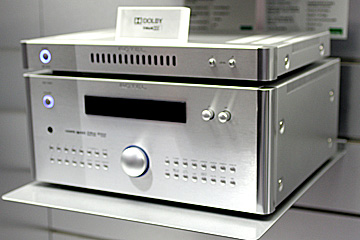
Rotel
|
That doesn’t mean there’s no use
for switching amps. They offer high output with very low power consumption, are usually
quite small, and usually offer far higher watt-per-dollar value than conventional designs.
And that’s the key with class-D: bang for the buck. This was reinforced by a long
discussion I had at the Expo with a rep from Rotel, a UK-based company known for making
affordable amplifier products, and a "sister" company to Canada’s high-end
Classé Audio. Rotel’s newest products are class-D designs, offered for the reasons
cited above. On the other hand, Classé, whose products cost far more, currently offers no
class-D amps, and seems to have no plans to.
Even within the class-D genre, companies are dabbling with
different technologies, and some have developed their own unique takes on the topology.
The one I hear about most often is ICEpower, developed by the Danish company Bang &
Olufsen (B&O). From what I understand, ICEpower offers good performance and is
reliable, cost-effective, and easy to implement. I have no hard data on just how many
companies use this module, but it seems far and away the most popular technology used in
class-D designs -- Rotel’s, for example.
In terms of amplification, I don’t see the landscape
of shows like the CEDIA Expo changing much in the next few years. Undoubtedly, more
class-D amplifiers will be coming along, but there will always be a place for conventional
solid-state amplifiers, even if they’re not as cheap or as practical. Unless and
until class-D designs come to be viewed as offering the ultimate in performance, there
will always be a demand for conventional amps from those who want the very best sound.
Next stop: Rocky Mountain Audio Fest
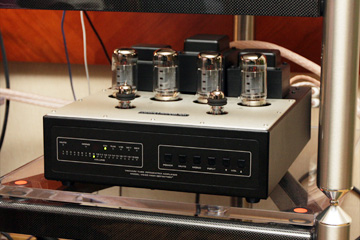
Audio Research
|
The Rocky Mountain Audio Fest began as a
hobbyist show dominated by very small companies usually offering tweaky products. Since
then the show has gone more mainstream, and now attracts the larger North American makers
and distributors of high-end audio gear, and some overseas companies as well. Unlike at
the home-theater-oriented CEDIA Expo, at RMAF you’ll find a broader range of
two-channel audio products and stereo amplifiers embracing most design topologies,
including tubes.
Although for reviewing purposes I primarily use solid-state
amplifiers for their high power, superb linearity, low distortion, and day-to-day
reliability, I can certainly appreciate the sound of a good tube amp, particularly if
it’s reliable and well priced. At home I have a Zanden Model 500 tube amp, and at
RMAF I was quite taken with Audio Research’s new VSi60 tubed integrated amplifier
($3995 USD). The VSi60, claimed to output 50Wpc, seems the ideal product for someone who
wants to dabble in tubes at a fairly reasonable price while enjoying the peace of mind
that comes from dealing with a rock-solid US company. Rogue Audio, which seemed absent
from this year’s RMAF, is another key player in this market -- it, too, is an
established US company known for producing well-designed, reasonably priced tube gear. A
large number of China-based companies produce tube amps, but most of these brands are
unknown quantities to me; as they say, buyer beware. The vacuum tube may be nearly a
century old, but among two-channel enthusiasts the technology is alive and well.
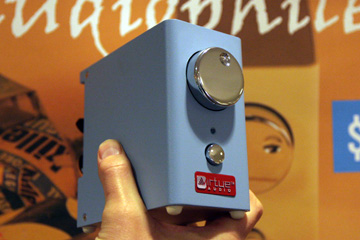
Virtue Audio
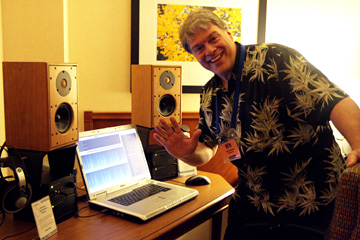
HeadRoom
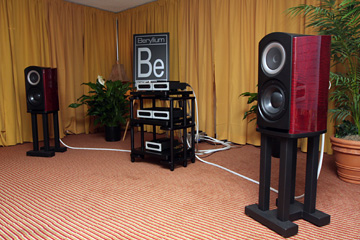
Bel Canto Design/TAD
|
But as I toured the rooms at RMAF, it became
abundantly clear that conventional solid-state amplification continues to rule the
high-end two-channel market, and probably for the same reasons I prefer it for reviewing.
There were plenty of interesting solid-state amps on display in Denver, but nothing really
new or groundbreaking. Come to think of it, there wasn’t anything really new in this
regard at the CEDIA Expo. Who knows? Perhaps conventional solid-state designs have reached
their peak.
The class-D market, however, is growing, and at RMAF I saw
some interesting things at various price points. Virtue Audio is a small company making a
big name for itself by offering amplifiers at very low prices. At this show they had on
display an integrated amplifier ($249), based on Tripath chip technology (Tripath calls it
a "class-T" design, but it’s really part of the class-D family), that quite
impressed Soundstage! Network reviewers Colin Smith and Howard Kneller. In fact, Colin
wants to get one to review. HeadRoom was showing small, relatively high-power amplifiers
from their Audiophile Desktop series ($899-$1699). HeadRoom’s amps are
ICEpower-based; they’d never have been able to make something as powerful and compact
as these desktop amps with conventional solid-state technology. Check out our SoundStage! V site to see the video we made at RMAF showing one
of their systems.
At the higher end of the class-D market is Bel Canto
Design. Years ago, Bel Canto made tube amps, then made a drastic shift to switching
designs, first using Tripath technology and now ICEpower. At RMAF I heard a system
comprising TAD speakers and all Bel Canto electronics (they also make CD players, DACs,
and preamps). The system cost a total of tens of thousands of dollars, but no doubt would
have cost even more had the amps been conventional designs delivering the same wattage.
Currently, Bel Canto’s most expensive amp is the 500W REF1000 Mk.II monoblock, which
sells for about $6000/pair. Not only will you have a hard time finding a conventional
design as powerful at that low a price, but even if you do, I guarantee that it won’t
be as small or run as cool. Again, no other amplifier topology can compete with class-D in
bang for the buck.
If, one day, the very best class-D amp outperforms the very
best conventional solid-state design, the amplifier landscape will drastically shift. For
now, conventional solid-state, though perhaps having reached a technical plateau, still
dominates; tubes are holding their own; and class-D technology is the cutting edge for
makers of amplifiers both high-end and affordable. It’ll be interesting to see
-- and hear -- what the next few years bring.
Coming soon . . .
Now is a great time to be an audiophile -- the audiophile
marketplace is more vibrant than it’s been in years. No matter what type of amplifier
fits your needs, you’ll find models at every price point -- the possibilities seem
almost endless, and that’s as it should be. Of course, you can’t choose the
right amp without taking into account the speakers it will drive. And that’s where
I’ll pick up the discussion next month.
. . . Doug Schneider
E-mail comments to the editor@goodsound.com.
|